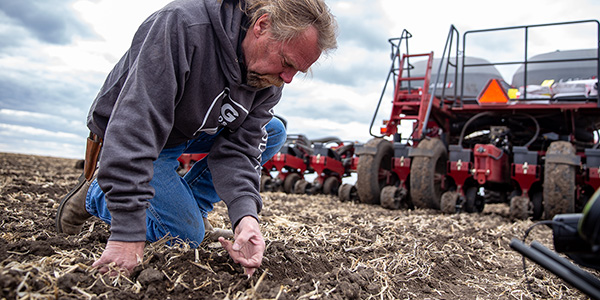AGRONOMICSUPPORT
YOU CAN TAKETO THE FIELD
Thinking about planting early? Consider these factors first.
For corn and (especially) soybeans, planting dates have skewed earlier and earlier in recent years.
Farming (along with almost everything else) has been kicked into overdrive. You’re trying to plant huge numbers of acres in a timely fashion. And optimizing the yield of every single acre is critical. With pressure rising on farmers nationwide because of continuously increasing input prices, extensive drought conditions and more – maximizing the land you have is more important than ever.
So, it’s no wonder farmers have wanted to get a head start on planting in the last few years.
But before you circle that earlier date on the calendar, there are a few factors to consider:
Double-check your crop insurance
Depending on your region and the type of crop insurance you have, your crops may or may not be covered before certain dates. For example, across the central part of the Midwest, corn and soybeans planted before April 10-15 are usually not eligible. Check your individual state’s planting dates to ensure your planting plan fits within the required window.
Keep tabs on 10-14 day weather forecasts
It’s not beneficial to plant early if soil conditions are poor. Corn needs the soil temperature to be around 50°F before it will germinate. Corn plants also don’t like their first drink to be cold, so rainfall after cold/early planting can cause plant development issues. Observing the 10-14 day forecasts before planting will make for an overall smoother planting season and increase your chances at consistently high yields.
Test out seed treatments
For soybeans, adding a seed treatment will probably be necessary to make good use of early planting. This helps protect the seeds from soilborne diseases and insects—especially if temperatures are hovering around the 50°F range and the seedlings stay below the soil surface for an extended period. Learn more about potential seed treatments and which are right for your operation.
Evaluate the cost/benefit of replanting
If you end up needing to replant, this can take extra time, labor, and energy that you don’t have (and which reduces your ROI). Even beyond that, it will likely be later in the season by the time replanting begins, so seed choices may be more limited than when you placed your original order. It’s important to plan in advance and know exactly how and why you’re planting early, so you can maximize your yield.
The bottom line? You have one chance to get your crops planted right. Factoring in weather forecasts, soil conditions, crop insurance requirements, seed treatments and seed placement will help you make the best decision to ensure continuous performance and high yields.





